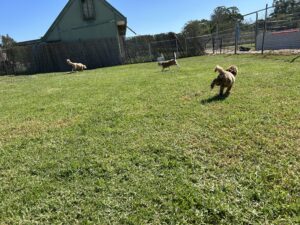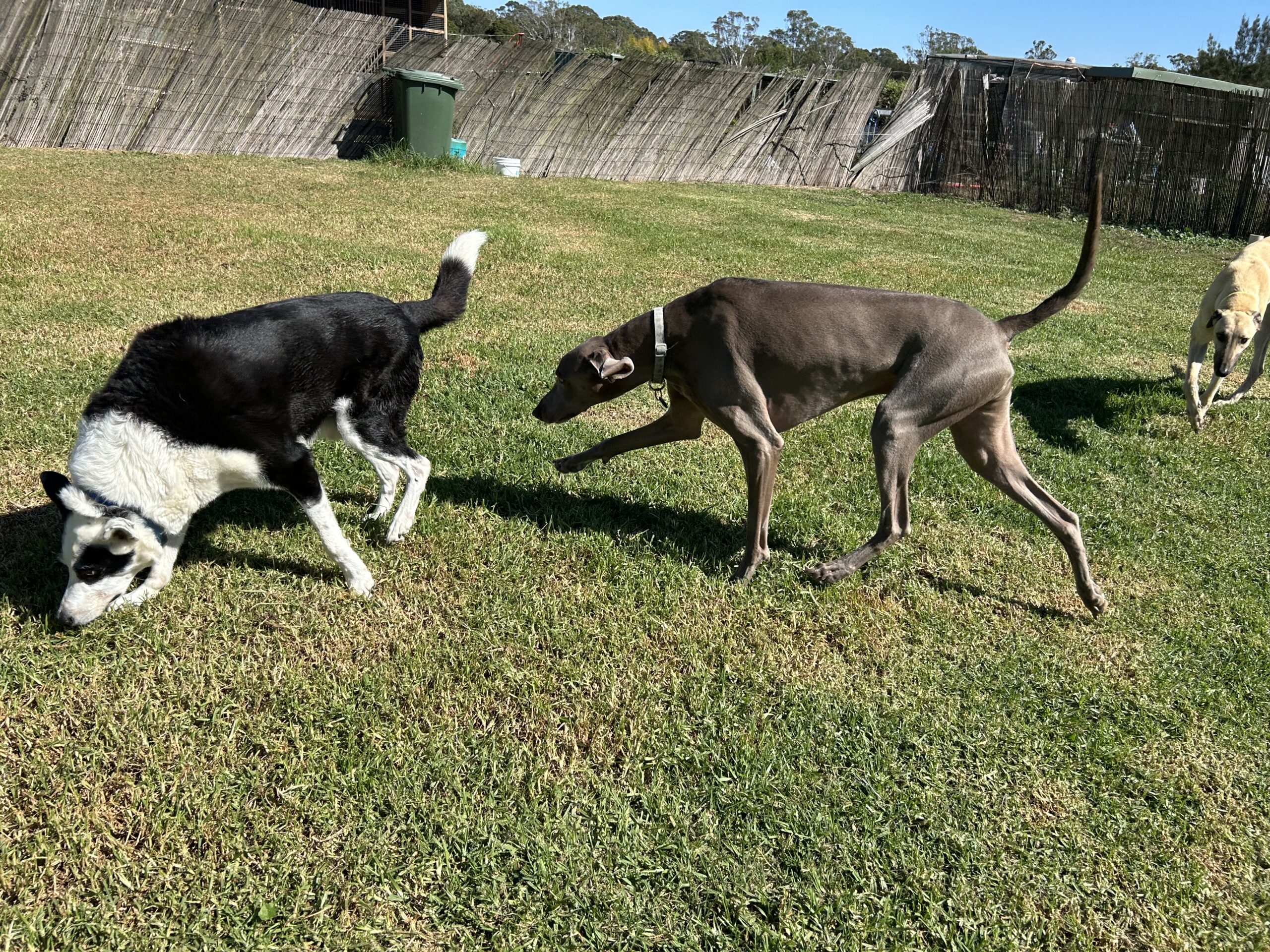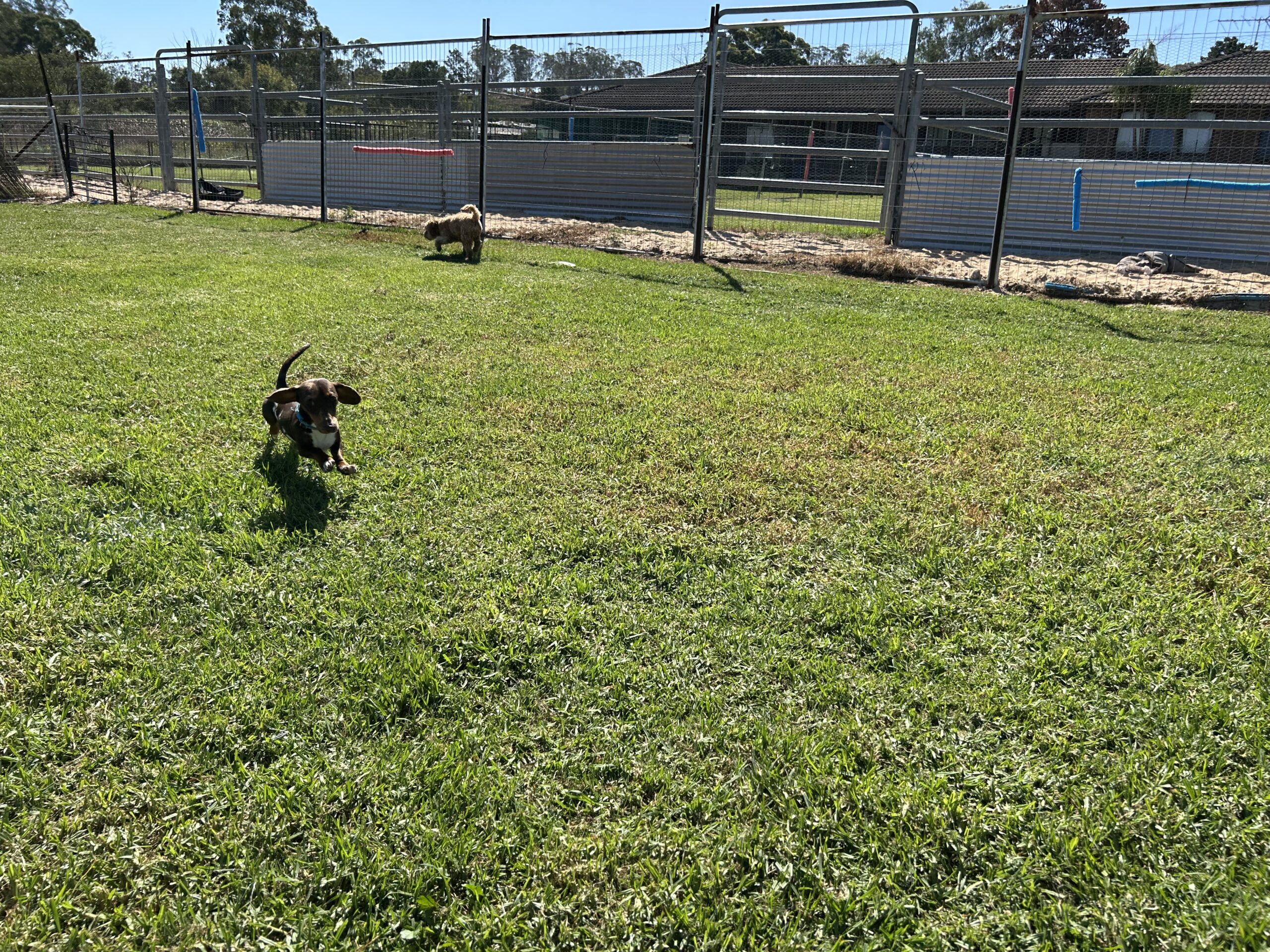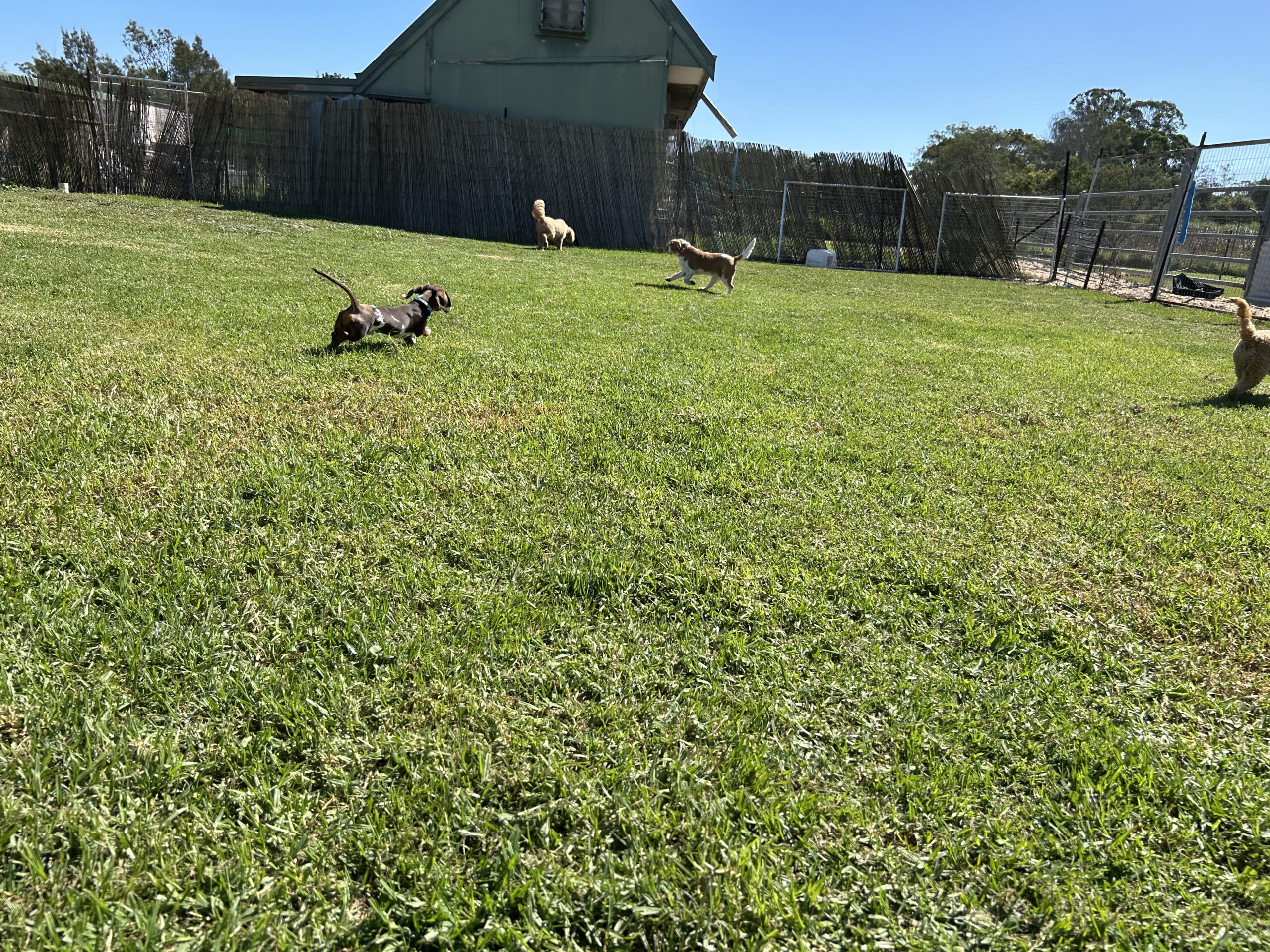Dog Adaptability Building: Joyful Resilience Through Strategic Exposure
Dog adaptability building through structured daycare experiences creates flexible, confident canines capable of navigating life’s inevitable changes with calm assurance rather than fear or reactivity. 
Key Takeaways: Building Resilience Through Daycare
| Essential Adaptability Benefits | Why It Matters |
|---|---|
| Dog adaptability building creates generalised confidence | Skills transfer to all novel situations, not just familiar ones |
| Controlled novelty exposure develops neural flexibility | Builds brain pathways that adapt rather than react to change |
| Graduated challenges build successful coping histories | Each positive experience creates resilience for future changes |
| ️ Professional oversight prevents overwhelming experiences | Ensures novelty remains beneficial rather than traumatic |
| Intentional variety prevents environmental narrowing | Dogs learn the world is diverse rather than rigidly predictable |
| Social adaptability transfers to environmental flexibility | Dogs who adapt to diverse playmates adapt better to all change |
| Systematic approach builds comprehensive resilience | Strategic exposure rather than random experiences |
| Early intervention prevents rigidity from developing | Easier to build adaptability than to reverse established inflexibility |
“The Inflexible Dog Crisis: Is Your ‘Stable Routine’ Creating a Canine Who Can’t Cope?”
Has your well-intentioned consistency inadvertently created a dog who panics at the slightest deviation from normal? Perhaps your pup freezes when encountering unfamiliar surfaces, barks excessively at new objects in the home, or becomes visibly distressed during routine disruptions like holiday travel or visiting guests.
Many devoted owners establish highly predictable environments believing this represents security, when research increasingly shows this approach often backfires dramatically. Veterinary behavioural science now recognises that excessive routine without balanced novelty creates “environmental narrowing”—a condition where dogs become pathologically inflexible, unable to cope with inevitable life changes.
Even more concerning, a groundbreaking study from the University of Melbourne found that dogs with limited early exposure to environmental variety showed a 78% higher rate of anxiety disorders and a 64% increased likelihood of developing fear-aggression toward novel stimuli compared to dogs with diverse early experiences.
The good news? Quality daycare offering resilience through daycare programs can systematically develop your dog’s adaptability through carefully structured novelty that builds confidence rather than creates distress.
Dog Adaptability Building Through Strategic Daycare Experiences
Dog adaptability building programs operate on a fundamental neurological principle: the brain requires regular, appropriate novelty to develop healthy flexibility. Unlike completely unpredictable environments that overwhelm, or rigidly consistent settings that create brittleness, quality resilience through daycare programs implement sophisticated exposure protocols that build adaptability without triggering fear.
“Most owners fundamentally misunderstand how adaptability develops,” explains Dr. Emma Richardson, veterinary neurologist. “Resilience doesn’t come from protection from change but from successful experiences navigating appropriate levels of novelty and challenge.”
Premier dog adaptability building facilities implement evidence-based strategies including:
- Systematic environmental enrichment rotating novel elements daily
- Strategic introduction to diverse textures, sounds, and visual stimuli
- Graduated exposure to manageable environmental changes
- Confidence-building protocols for novel experiences
- Professional monitoring ensuring positive adaptation experiences
- Carefully curated social exposure to diverse play styles and personalities
- Controlled challenge progressions building comprehensive flexibility
These aren’t random experiences but carefully orchestrated neurological interventions designed by canine development specialists. The adaptability developed through dog adaptability building programs creates lifelong resilience to change that benefits both dogs and their families.
Resilience Through Daycare: The Neuroscience of Adaptive Capacity
Dog adaptability building programs utilise cutting-edge understanding of canine neurology to develop flexible brain architecture. Research from the University of Sydney’s Canine Cognition Centre found that dogs receiving structured novelty exposure showed 65% greater activity in brain regions associated with cognitive flexibility and 42% lower reactivity in threat-assessment areas when facing novel stimuli.
During professionally designed resilience through daycare experiences, your dog’s neurological systems undergo sophisticated development:
- Formation of diverse neural pathways creating multiple response options
- Balanced activation of curiosity circuits rather than threat detection
- Development of appropriate stress-recovery patterns building resilience
- Strengthening of executive function overriding reactive tendencies
- Creation of positive novelty associations supporting lifelong adaptability
“These dog adaptability building techniques create fundamental changes in brain architecture,” notes canine neuropsychologist Dr. James Wilson. “In quality resilience through daycare settings, we’re not just exposing dogs to random experiences—we’re systematically developing their neural flexibility through strategically designed novelty.”
Is Your Dog Struggling with Adaptability? Take This Assessment:
- Does your dog show distress when routines change (different walking route, schedule changes)?
- Does your dog resist or fear unfamiliar surfaces, objects, or environments?
- Does your dog become anxious or shut down when encountering new people or situations?
- Does your dog take excessive time to adjust to changes in the home environment?
- Has your dog’s world become progressively smaller as they avoid novel experiences?
If you answered “yes” to three or more questions, your dog likely has significant adaptability deficits—precisely the condition that specialised dog adaptability building programs address through structured flexibility development.
Specialized Techniques for Building Adaptability at Quality Daycares
Premier dog adaptability building facilities implement evidence-based protocols designed specifically for developing flexibility. These aren’t recreational programs but sophisticated neurological development interventions created by canine behaviour specialists.
“The difference between random exposure and structured adaptability building is profound,” explains Dr. Sarah Williams, canine developmental psychologist. “Proper dog adaptability building programs systematically develop neural flexibility through carefully sequenced experiences rather than overwhelming or underwhelming the system.”
Leading resilience through daycare programs feature techniques such as:
Systematic Environmental Rotation
Strategic introduction to diverse environments with carefully controlled variables—building adaptability to different settings while maintaining sufficient familiarity to prevent overwhelm.
Novelty Integration Training
Controlled introduction of novel elements within familiar contexts—teaching dogs that change can occur within a framework of security, preventing the association of novelty with threat.
Recovery Skill Development
Guided experiences teaching specific regulation techniques when facing change—building the critical ability to return to emotional baseline after novelty exposure.
Graduated Challenge Sequencing
Carefully structured progression of adaptive challenges calibrated to individual temperament—creating a history of successful coping that builds confidence for future changes.
Case Study: Bella’s Transformation Through Adaptability Building
Before: Bella, a 3-year-old Kelpie/Border Collie cross, exemplified environmental inflexibility despite loving care. Her family reported extreme distress when encountering unfamiliar objects, surfaces, or environments. Simple changes like furniture rearrangement triggered hours of anxious pacing, and holidays became impossible as she couldn’t adapt to new accommodations. Her world had progressively shrunk to a limited circuit of familiar locations and experiences.
The Dog Adaptability Building Program: Bella began attending a specialised resilience through daycare program three days weekly. Staff conducted an initial assessment and created a personalised adaptability protocol:
- Week 1-2: Establishing secure base with minimal, non-threatening novelty
- Weeks 3-4: Introduction to controlled environmental changes below threshold
- Weeks 5-8: Graduated exposure to diverse environments with increasing novelty
- Ongoing: Systematic resilience building with incrementally challenging situations
Measurable Results After Ten Weeks:
- 85% reduction in stress responses to environmental changes
- Successful adaptation to unfamiliar surfaces and environments
- Significantly reduced recovery time after encountering novelty
- Development of active exploration rather than avoidance of new situations
“The transformation in Bella was nothing short of miraculous,” reports her owner, Sarah. “The dog adaptability building approach completely changed her experience of the world. The staff never forced her beyond what she could handle, but systematically expanded what she could tolerate. We can now take holidays, rearrange furniture, and introduce new objects without triggering panic. Her world has expanded immeasurably.”
Signs Your Dog is Building Adaptability Through Quality Daycare
Not all dog daycare facilities provide genuine resilience development. Many simply offer random experiences without understanding the neurological principles of adaptability building. To determine whether your dog adaptability building program is providing true benefits, monitor these evidence-based indicators:
- Your dog shows decreased startle responses to environmental changes
- Recovery time after novel experiences becomes progressively shorter
- Your dog demonstrates increased voluntary exploration of new situations
- Stress signals during routine disruptions diminish in frequency and intensity
- Your dog shows greater curiosity rather than fear toward novelty
- Adaptability improvements generalise across different types of changes
- Your dog maintains functionality during environmental transitions
Dr. Thomas Chen, veterinary behavioural neurologist, explains: “Effective dog adaptability building produces distinct neurological changes that manifest as improved flexibility. When dogs receive appropriate resilience training, the transformation extends beyond specific scenarios—they develop fundamental neural architecture supporting adaptability in all contexts.”
Adaptability Development Comparison: Rigid Routine vs. Strategic Flexibility
| Adaptability Building Needs | Consistency-Focused Approach | Dog Adaptability Building Benefits |
|---|---|---|
| Neural pathway development | Limited connections creating rigid responses | Diverse pathways supporting multiple response options |
| Novelty response system | Threat-detection emphasis creating fear | Curiosity-circuit activation promoting exploration |
| Recovery skill acquisition | Minimal practice with little variation | Regular opportunities developing regulation abilities |
| Stress inoculation | Avoidance creating vulnerability | Strategic exposure building resilience |
| Environmental expansion | Progressive narrowing of comfortable zones | Systematic expansion of capability boundaries |
| Challenge calibration | Either none or overwhelming | Precisely matched to individual threshold |
| Generalisation capacity | Learning tied to specific contexts | Skills transfer across diverse situations |
| Owner freedom impact | Family life restricted by dog’s inflexibility | Increased options for family activities and changes |
Long-Term Benefits of Adaptability-Building Daycare
Dog adaptability building programs focused on neural flexibility offer enduring cognitive benefits that extend throughout your dog’s lifetime. Recent research from the University of Queensland’s Canine Cognition Centre revealed that dogs receiving structured adaptability training showed significantly improved problem-solving abilities in novel situations and maintained their flexible response patterns even when facing unprecedented challenges months after program completion.
“We now understand that appropriate adaptability training creates permanent changes in neural architecture,” explains cognitive neuroscientist Dr. Robert Thompson. “The flexibility developed through these programs fundamentally alters how dogs process and respond to environmental changes, creating lifelong resilience.”
Evidence-based dog adaptability building benefits include:
- Development of generalised confidence extending to all novel situations
- Formation of adaptive rather than reactive neural circuitry
- Enhanced problem-solving abilities when facing changes or challenges
- Improved capacity to function in diverse environments
- Better stress regulation during inevitable life transitions
- Increased behavioural options when responding to novelty
- Greater family freedom as dog can adapt to changing circumstances
These neurological benefits accumulate over time, with each resilience through daycare experience contributing to your dog’s lifelong adaptability and ability to navigate change with confidence.
How Different Dog Types Benefit from Adaptability-Building Daycare
Dog adaptability building programming recognises that flexibility development needs vary based on breed characteristics, age, and individual temperament. Leading facilities conduct thorough assessments to customise resilience protocols:
High-Sensitivity Breeds
Border Collies, Australian Shepherds, and similar environmentally sensitive breeds require dog adaptability building programs emphasizing extremely gradual exposure and strong success reinforcement to overcome their natural vigilance toward change.
Genetically Vigilant Types
Guardian breeds with innate suspicion of novelty need specialised dog adaptability building approaches focusing on positive novelty experiences that counterbalance their protective tendencies.
Early-Life Deprived Dogs
Dogs with limited early exposure to environmental variety require remedial dog adaptability building protocols providing carefully calibrated experiences that fill developmental gaps without overwhelming.
Age-Specific Adaptability Support
Senior dogs with established patterns benefit from adapted dog adaptability building approaches accounting for their longer history of environmental expectations while gently expanding their flexibility.
Adaptability-Building Daycare Evaluation Checklist
Not all facilities claiming to build resilience truly understand neurological development. Use this evidence-based checklist when evaluating potential dog adaptability building providers:
- Staff with specific training in canine neurological development (not just general care)
- Individual adaptability assessment protocols before program development
- Systematic approach to novelty introduction rather than random exposure
- Physical facility designed with variable elements allowing controlled changes
- Customised resilience plans based on individual adaptability profiles
- Professional monitoring and documentation of flexibility progress
- Regular communication regarding adaptability improvements and home implementation
- Clear understanding of the balance between security and novelty
Critical Questions for Adaptability-Building Daycare Providers
When interviewing potential resilience through daycare facilities, ask these revealing questions to assess their developmental expertise:
- “How do you assess my dog’s current adaptability threshold?”
- “What specific protocols do you implement for building flexibility rather than creating fear?”
- “How do you balance security and novelty in your program?”
- “What systems do you have for ensuring novelty remains beneficial rather than overwhelming?”
- “How do you measure progress in adaptability development?”
- “What credentials do your staff hold specifically related to canine neurological development?”
The facility’s ability to provide substantive, detailed responses reveals their true commitment to adaptability development versus facilities offering simple recreational experiences.
Conclusion: Transform Rigidity into Resilient Flexibility
Dog adaptability building programs offer a sophisticated alternative to both excessive routine and unpredictable chaos. By providing neurologically informed flexibility development, these specialised programs build the adaptive capacity that allows dogs to navigate our ever-changing world with confidence rather than fear.
Each dog adaptability building experience creates incremental improvements in neural flexibility. The cumulative effect develops a dog who approaches novelty with curiosity rather than alarm—transforming their fundamental experience of environmental change from threat to opportunity.
“When we examine the neurological evidence,” notes Dr. Jessica Moore, veterinary behaviourist, “the conclusion is clear: structured resilience development through specialised dog adaptability building represents one of the most valuable investments in your dog’s lifelong wellbeing and your family’s freedom.”
Your dog deserves the psychological freedom that comes from adaptability rather than the prison of environmental rigidity. Schedule a developmental assessment today to discover how a quality dog adaptability building program can transform your dog’s relationship with change through proper resilience development.
External Links:
- Canine Boarding Lodge
- Mobile Dog Grooming Services
- Canine Glamour Facebook
- Canine Glamour Instagram
- Canine Glamour TikTok
- Canine Boarding Lodge Facebook
Follow for more: For more grooming tips visit: FB: Canine glamour Instagram: Canine glamour TikTok: Canine Glamour For more boarding tips visit: FB: Canine boarding lodge
SEO Title:
Dog Adaptability Building: Unleash 7 Resilient Strategies
Meta Description:
Dog adaptability building creates flexible, confident canines who navigate change with ease. Discover how structured daycare builds neural resilience for life.




